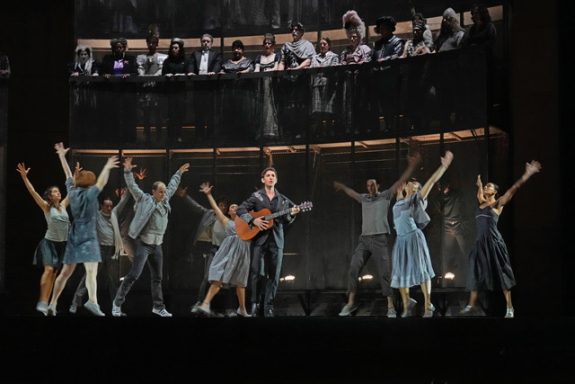 United States Gluck, Orfeo ed Euridice: Soloists, Chorus and Orchestra of Metropolitan Opera / J. David Jackson (conductor). Metropolitan Opera, New York, 8.6.2024. (RP)
United States Gluck, Orfeo ed Euridice: Soloists, Chorus and Orchestra of Metropolitan Opera / J. David Jackson (conductor). Metropolitan Opera, New York, 8.6.2024. (RP)

Production:
Production and Choreographer – Mark Morris
Sets – Allen Moyer
Costumes – Isaac Mizrahi
Lighting – James F. Ingalls
Chorus master – Donald Palumbo
Cast:
Orfeo – Anthony Roth Costanzo
Amore – Elena Villalón
Euridice – Ying Fang
The Metropolitan Opera ended the 2023/24 season with Mark Morris’s delightful production of Gluck’s Orfeo ed Euridice. It was also the occasion to celebrate Donald Palumbo’s departure after seventeen years as the Met’s chorus master. And if that wasn’t enough reason to rejoice, the Met was packed on a glorious June afternoon.
Morris is best known as an American dancer, choreographer and director, but he has dabbled a fair bit in opera as well. He has choreographed productions for the Met, New York City Opera, English National Opera and the Royal Opera House, Covent Garden, among others. As a director, his work includes Purcell’s King Arthur for the English National Opera and this production of Gluck’s Orfeo ed Euridice from 2007, which he also choreographed.
By their very nature, myths are universal. The tale of Orpheus with his lute coaxing the Furies to let him pass through the Gates of Hades to retrieve his wife Euridice from the dead has inspired composers for centuries. Orpheus can return with Euridice only if he neither looks at her nor explains why he cannot do so. Being mere mortals, they are fated to fail.

If one could bottle Morris’s magic touch in tinkering with time and place while remaining true to the spirit of a work, the opera world would be a far happier place. Orpheus is envisioned as a country-western singer in black with a guitar slung over his shoulder. Amore is a spunky kid with little pink wings who descends from the sky, while Euridice is a vision of loveliness in a flowing white gown.
The set itself is two massive units in which the chorus sits in rows. The components are rearranged to create the Gates of Hades and other locales. Reversed, they are transformed into the dark labyrinth through which Orpheus leads Euridice and breaks his vow. It is a wonderfully foreboding, glittery and black space, as well as a bit magical.
At the beginning of the opera, Orpheus appeals to the immortals that Euridice be returned to him. Morris supplies them in abundance with individual chorus members costumed as historical figures. Abraham Lincoln’s black top hat, Mae West’s portrait topper complete with ostrich feathers and Queen Elizabeth I’s standing ruff and red hair stood out prominently among the personages.
Orfeo ed Euridice exists in several versions, and the Met opted for the original Viennese one of 1762, with inclusion of ‘Dance of the Blessed Spirits’ and ‘Dance of the Furies’, both of which date from the 1774 French version. Morris made movement as important as music in creating the intense emotions of the story. The dancers were dressed in rather drab modern-day dress, until the final scene when they became a riot of color.
The Met assembled an ideal cast for this revival. As Orfeo, countertenor Anthony Roth Costanzo sang with the utmost sensitivity, expression and musicianship. His cries of ‘Euridice’ in the opening scene were heartrending. Even at its softest, his voice carried effortlessly throughout the auditorium, while his phrasing of Gluck’s beautiful melodies was perfection.
Ying Fang was an exquisite Euridice in both voice and appearance. Her soprano conveyed Euridice’s roller-coaster ride of emotions in limpid, lovely tones. Fang and Costanzo all but stopped the show with ‘Vieni, appaga il tuo consorte’, Orfeo and Euridice’s Act III duo in which he must suffer in silence as she reproaches him for his aloofness.
Soprano Elena Villalón, who hails from Austin, Texas, made her Met debut earlier in the season as Amore. With her spunky personality and sparkling voice, she conquered every heart.
Gluck places the chorus on equal footing dramatically with the solo singers in Orfeo ed Euridice. In Morris’s staging, the Met chorus was free to focus solely on singing, and they sounded wonderful. The Furies’ cries of ‘No!’ as Orfeo pleaded to enter the Underworld were spine chilling.
In the pit, J. David Jackson led a performance that was as intimate as it was grand. The orchestra played with exceptional lightness and elegance, and solo instruments, particularly the harp and flute, conveyed as much emotion as any performer on the stage.
Although the myth ends in tragedy, Gluck and his librettist were compelled by circumstances to provide a happy ending to the opera. Nymphs and shepherds joined Amore, Orpheus and Euridice in a joyous celebration of love as the curtain fell.
There was more to come, however, as Peter Gelb, the Met’s general manager, appeared on stage to congratulate Palumbo for his time as chorus master. Gelb presented him with a giant gold lifetime ticket to the Met in honor of his services. Then there was a pop, and gold confetti rained down on all.
Rick Perdian
